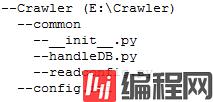Python 官方文档:入门教程 => 点击学习
目录python读取配置文件-ConfigParser二次封装直接上上代码读取配置文件&&简单封装1.configparser模块2.configparser读取文件
test.conf
[database]
connect = Mysql
sleep = no
test = yesconfig.py
# -*- coding:utf-8 -*-
__author__ = 'guoqianqian'
import os
import ConfigParser
import os
current_dir = os.path.abspath(os.path.dirname(__file__))
class OperationalError(Exception):
"""operation error."""
class Dictionary(dict):
""" custom dict."""
def __getattr__(self, key):
return self.get(key, None)
__setattr__ = dict.__setitem__
__delattr__ = dict.__delitem__
class Config:
def __init__(self, file_name="test", cfg=None):
"""
@param file_name: file name without extension.
@param cfg: configuration file path.
"""
env = {}
for key, value in os.environ.items():
if key.startswith("TEST_"):
env[key] = value
config = ConfigParser.ConfigParser(env)
if cfg:
config.read(cfg)
else:
config.read(os.path.join(current_dir, "conf", "%s.conf" % file_name))
for section in config.sections():
setattr(self, section, Dictionary())
for name, raw_value in config.items(section):
try:
# Ugly fix to avoid '0' and '1' to be parsed as a
# boolean value.
# We raise an exception to Goto fail^w parse it
# as integer.
if config.get(section, name) in ["0", "1"]:
raise ValueError
value = config.getboolean(section, name)
except ValueError:
try:
value = config.getint(section, name)
except ValueError:
value = config.get(section, name)
setattr(getattr(self, section), name, value)
def get(self, section):
"""Get option.
@param section: section to fetch.
@return: option value.
"""
try:
return getattr(self, section)
except AttributeError as e:
raise OperationalError("Option %s is not found in "
"configuration, error: %s" %
(section, e))
if __name__ == "__main__":
conf = Config()
print conf.get("database").connect
print conf.get("database").sleep
print conf.get("database").test
执行结果
mysql
False
True
目录结构
demo
conf
test.conf
config.py之前有做过把爬虫数据写到数据库中的练习,这次想把数据库信息抽离到一个ini配置文件中,这样做的好处在于可以在配置文件中添加多个数据库,方便切换(另外配置文件也可以添加诸如邮箱、url等信息)
python使用自带的configparser模块用来读取配置文件,配置文件的形式类似windows中的ini文件
在使用前需要先安装该模块,使用pip安装即可
(1)新建一个config.ini文件,如下

(2)新建一个readconfig.py文件,读取配置文件的信息
import configparser
cf = configparser.ConfigParser()
cf.read("E:\Crawler\config.ini") # 读取配置文件,如果写文件的绝对路径,就可以不用os模块
secs = cf.sections() # 获取文件中所有的section(一个配置文件中可以有多个配置,如数据库相关的配置,邮箱相关的配置, 每个section由[]包裹,即[section]),并以列表的形式返回
print(secs)
options = cf.options("Mysql-Database") # 获取某个section名为Mysql-Database所对应的键
print(options)
items = cf.items("Mysql-Database") # 获取section名为Mysql-Database所对应的全部键值对
print(items)
host = cf.get("Mysql-Database", "host") # 获取[Mysql-Database]中host对应的值
print(host)上述代码运行结果如下,可以和config.ini进行对比

工程目录如下:

readconfig.py:
import configparser
import os
root_dir = os.path.dirname(os.path.abspath('.')) # 获取当前文件所在目录的上一级目录,即项目所在目录E:\Crawler
cf = configparser.ConfigParser()
cf.read(root_dir+"/config.ini") # 拼接得到config.ini文件的路径,直接使用
secs = cf.sections() # 获取文件中所有的section(一个配置文件中可以有多个配置,如数据库相关的配置,邮箱相关的配置,每个section由[]包裹,即[section]),并以列表的形式返回
print(secs)
options = cf.options("Mysql-Database") # 获取某个section名为Mysql-Database所对应的键
print(options)
items = cf.items("Mysql-Database") # 获取section名为Mysql-Database所对应的全部键值对
print(items)
host = cf.get("Mysql-Database", "host") # 获取[Mysql-Database]中host对应的值
print(host)或者使用os.path.join()进行拼接
import configparser
import os
root_dir = os.path.dirname(os.path.abspath('.')) # 获取当前文件所在目录的上一级目录,即项目所在目录E:\Crawler
configpath = os.path.join(root_dir, "config.ini")
cf = configparser.ConfigParser()
cf.read(configpath) # 读取配置文件
secs = cf.sections() # 获取文件中所有的section(一个配置文件中可以有多个配置,如数据库相关的配置,邮箱相关的配置,每个section由[]包裹,即[section]),并以列表的形式返回
print(secs)
options = cf.options("Mysql-Database") # 获取某个section名为Mysql-Database所对应的键
print(options)
items = cf.items("Mysql-Database") # 获取section名为Mysql-Database所对应的全部键值对
print(items)
host = cf.get("Mysql-Database", "host") # 获取[Mysql-Database]中host对应的值
print(host)重新写一下之前的requests+正则表达式爬取猫眼电影的例子
把读取配置文件readconfig.py和操作数据库handleDB.py分别封装到一个类中
readconfig.py如下
import configparser
import os
class ReadConfig:
"""定义一个读取配置文件的类"""
def __init__(self, filepath=None):
if filepath:
configpath = filepath
else:
root_dir = os.path.dirname(os.path.abspath('.'))
configpath = os.path.join(root_dir, "config.ini")
self.cf = configparser.ConfigParser()
self.cf.read(configpath)
def get_db(self, param):
value = self.cf.get("Mysql-Database", param)
return value
if __name__ == '__main__':
test = ReadConfig()
t = test.get_db("host")
print(t)handleDB.py如下
# coding: utf-8
# author: hmk
from common.readconfig import ReadConfig
import pymysql.cursors
class HandleMysql:
def __init__(self):
self.data = ReadConfig()
def conn_mysql(self):
"""连接数据库"""
host = self.data.get_db("host")
user = self.data.get_db("user")
passWord = self.data.get_db("password")
db = self.data.get_db("db")
charset = self.data.get_db("charset")
self.conn = pymysql.connect(host=host, user=user, password=password, db=db, charset=charset)
self.cur = self.conn.cursor()
def execute_sql(self, sql, data):
"""执行操作数据的相关sql"""
self.conn_mysql()
self.cur.execute(sql, data)
self.conn.commit()
def search(self, sql):
"""执行查询sql"""
self.conn_mysql()
self.cur.execute(sql)
return self.cur.fetchall()
def close_mysql(self):
"""关闭数据库连接"""
self.cur.close()
self.conn.close()
if __name__ == '__main__':
test = HandleMysql()
sql = "select * from maoyan_movie"
for i in test.search(sql):
print(i)最后的运行文件,调用前面的方法
# coding: utf-8
# author: hmk
import requests
import re
from common import handleDB
class Crawler:
"""定义一个爬虫类"""
def __init__(self):
self.db = handleDB.HandleMysql()
@staticmethod
def get_html(url, header):
response = requests.get(url=url, headers=header)
if response.status_code == 200:
return response.text
else:
return None
@staticmethod
def get_data(html, list_data):
pattern = re.compile(r'<dd>.*?<i.*?>(\d+)</i>.*?' # 匹配电影排名
r'<p class="name"><a.*?data-val=".*?">(.*?)' # 匹配电影名称
r'</a>.*?<p.*?class="releasetime">(.*?)</p>' # 匹配上映时间
r'.*?<i.*?"integer">(.*?)</i>' # 匹配分数的整数位
r'.*?<i.*?"fraction">(.*?)</i>.*?</dd>', re.S) # 匹配分数小数位
m = pattern.findall(html)
for i in m: # 因为匹配到的所有结果会以列表形式返回,每部电影信息以元组形式保存,所以可以迭代处理每组电影信息
ranking = i[0] # 提取一组电影信息中的排名
movie = i[1] # 提取一组电影信息中的名称
release_time = i[2] # 提取一组电影信息中的上映时间
score = i[3] + i[4] # 提取一组电影信息中的分数,这里把分数的整数部分和小数部分拼在一起
list_data.append([ranking, movie, release_time, score]) # 每提取一组电影信息就放到一个列表中,同时追加到一个大列表里,这样最后得到的大列表就包含所有电影信息
def write_data(self, sql, data):
self.db.conn_mysql()
try:
self.db.execute_sql(sql, data)
print('导入成功')
except:
print('导入失败')
self.db.close_mysql()
def run_main(self):
start_url = 'Http://maoyan.com/board/4'
depth = 10 # 爬取深度(翻页)
header = {"Accept": "text/html,application/xhtml+xml,application/xml;q=0.9,image/WEBp,*/*;q=0.8",
"Accept-Encoding": "gzip, deflate, sdch",
"Accept-Language": "zh-CN,zh;q=0.8",
"Cache-Control": "max-age=0",
"Connection": "keep-alive",
"Host": "maoyan.com",
"Referer": "http://maoyan.com/board",
"Upgrade-Insecure-Requests": "1",
"User-Agent": "Mozilla/5.0 (Windows NT 6.1; Win64; x64) AppleWebKit/537.36 (KHTML, like Gecko) Chrome/49.0.2623.75 Safari/537.36"}
for i in range(depth):
url = start_url + '?offset=' + str(10 * i)
html = self.get_html(url, header)
list_data = []
self.get_data(html, list_data)
for i in list_data:
"""这里的list_data参数是指正则匹配并处理后的列表数据(是一个大列表,包含所有电影信息,每个电影信息都存在各自的一个列表中;
对大列表进行迭代,提取每组电影信息,这样提取到的每组电影信息都是一个小列表,然后就可以把每组电影信息写入数据库了)"""
movie = i # 每组电影信息,这里可以看做是准备插入数据库的每组电影数据
sql = "insert into maoyan_movie(ranking,movie,release_time,score) values(%s, %s, %s, %s)" # sql插入语句
self.write_data(sql, movie)
if __name__ == '__main__':
test = Crawler()
test.run_main()以上为个人经验,希望能给大家一个参考,也希望大家多多支持编程网。
--结束END--
本文标题: Python读取配置文件-ConfigParser的二次封装方法
本文链接: https://lsjlt.com/news/138928.html(转载时请注明来源链接)
有问题或投稿请发送至: 邮箱/279061341@qq.com QQ/279061341
2024-03-01
2024-03-01
2024-03-01
2024-02-29
2024-02-29
2024-02-29
2024-02-29
2024-02-29
2024-02-29
2024-02-29
回答
回答
回答
回答
回答
回答
回答
回答
回答
回答
0